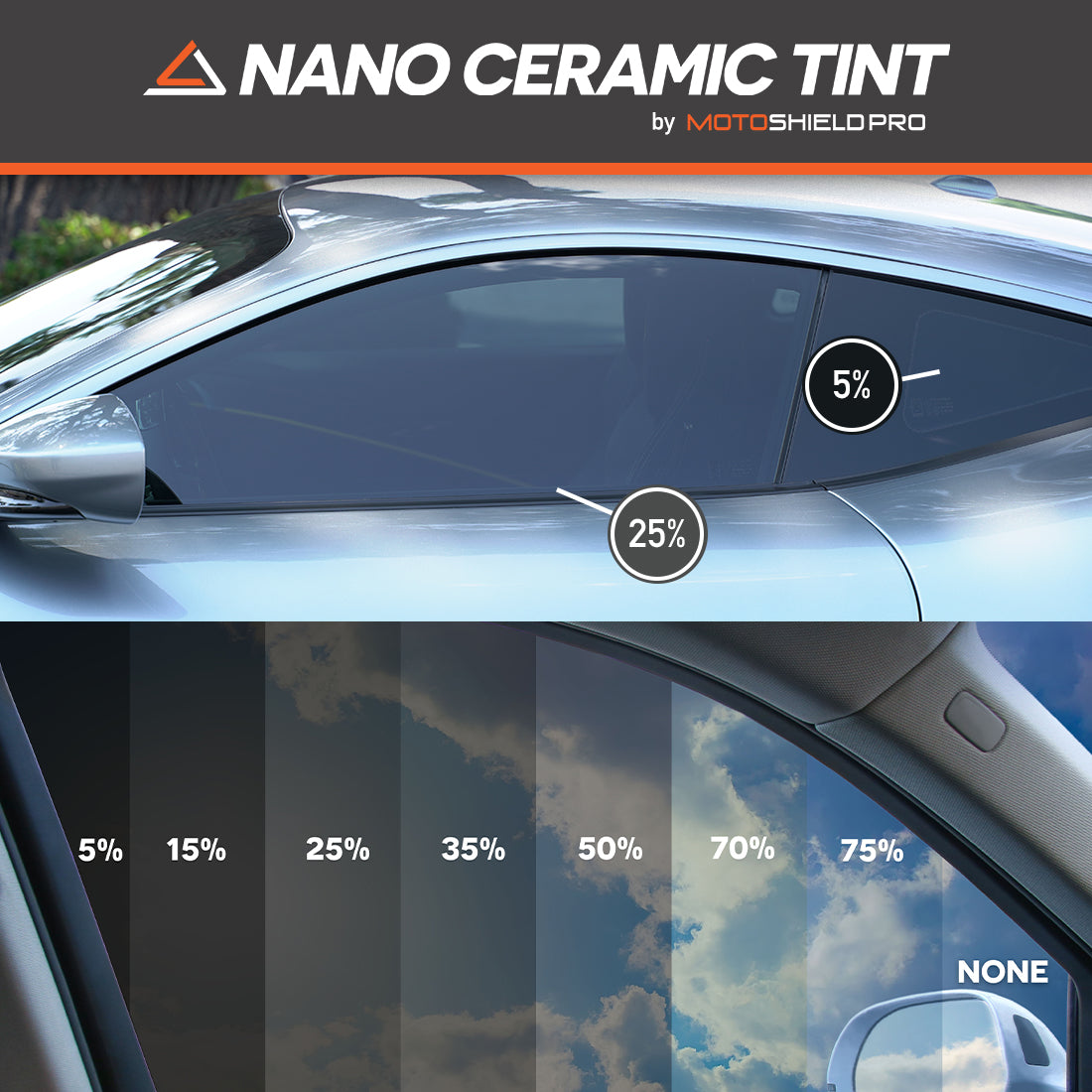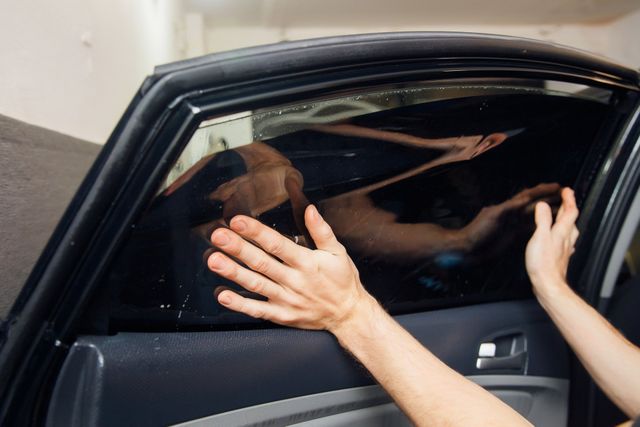Window Tinting Options: Find the Right Shade for Your Style and Requirements
Picking the proper window tint for your lorry entails a careful consideration of different elements, including individual aesthetics, useful demands, and lawful limitations. With options varying from light tintss that supply minimal personal privacy to darker shades that improve seclusion, the selections can be frustrating. window tinting. Understanding the effects of visible light transmission (VLT) percentages and the benefits of different products is crucial in making an informed option. As you contemplate your options, you might question exactly how these elements interaction to create not just an appearance, however a tailored experience on the road.
Recognizing Window Tinting Levels
When considering window tinting, it is important to recognize the numerous degrees of tint available, as they substantially affect both visual appeals and functionality. Window tinting is classified based on Visible Light Transmission (VLT) portions, which indicate the amount of light enabled to travel through the glass. The VLT percent can range from really light (over 70%) to really dark (below 5%)
The primary levels of tint consist of clear, which offers UV security without modifying exposure; light tint (over 50% VLT), which somewhat reduces glow while maintaining exposure; tool tint (around 35% VLT), striking an equilibrium in between personal privacy and light transmission; and dark tint (below 20% VLT), offering significant privacy and heat decrease yet restricting exterior presence.
Understanding these levels is critical as they can influence driving safety, lawful conformity, and individual comfort. Additionally, neighborhood laws commonly dictate permitted tint degrees, varying by state or district. Therefore, prior to selecting a tint, it is recommended to study and guarantee adherence to these policies while considering personal preferences for style and functional benefits.
Popular Tint Tone Explained

One of one of the most prominent options is the traditional dark tint, typically ranging from 20% to 5% VLT (Noticeable Light Transmission) This shade supplies maximum privacy and a sleek, sophisticated appearance. It successfully obstructs UV rays and warmth, making it suitable for sunny climates, though it might restrict visibility in the evening.
Conversely, lighter shades such as 35% or 50% VLT give a much more refined look while still providing some level of privacy. These tones are ideal for those seeking an equilibrium in between aesthetic appeals and performance, as they enable better exposure and adhere to various legal standards.
An additional arising preference is the ceramic tint, which can be available in a variety of shades - window tinting. It offers remarkable warm rejection and UV defense without substantially changing the car's look

Legal Laws for Window Tinting
Understanding the legal guidelines bordering window tinting is essential for lorry proprietors seeking to personalize their cars. Each state in the U.S. has certain legislations governing the darkness or lightness of window tintss, often gauged by Visible Light Transmission (VLT) percent. VLT refers to the quantity of light that can go through the glass and the movie combined.
In lots of states, laws determine various VLT percentages for various windowss, including front windshields, side windowss, and rear windowss. Some states might enable a color of 70% VLT for windscreens while allowing darker tintss for back windowss. Furthermore, certain states have constraints on reflective tintss, which can create glare for various other motorists.
Failing to conform with these policies can lead to penalties, mandated elimination of the tint, and raised insurance costs. Lorry owners ought to get in touch with regional laws or state DMV web sites to ensure they are within legal limits prior to proceeding with setup. Comprehending these regulations not only assists avoid lawful consequences yet additionally makes certain a risk-free driving experience.
Benefits of Different Tint Materials
Exploring the advantages of different tint materials discloses considerable advantages that can improve both the functionality and visual appeal of a vehicle. Each product uses unique qualities suited to specific needs and choices.
Dyeded window films are preferred for their affordability and capacity to decrease glare. They properly block UV rays, shielding the interior from fading, though they might not offer the highest possible warm rejection. Metalized films, on the other hand, deal exceptional warm reduction and UV defense due to their reflective homes. They can enhance privacy and safety and security but may disrupt digital signals.
Ceramic window films stand for a premium option, giving exceptional heat rejection while maintaining presence. They are non-metallic, hence preventing any kind of signal disturbance, and are highly durable, resisting scratches and fading with time. Additionally, ceramic films do not contain dyes, guaranteeing a longer-lasting appearance.
Lastly, hybrid films incorporate components from dyeded and metalized choices, supplying a well balanced performance in regards to warmth being rejected, glow decrease, and expense. Each tint material serves unique objectives, enabling car owners to choose the most effective suitable for their way of life and aesthetic preferences, ultimately boosting their driving experience.
Picking the Right Tint for You
Finding the right window tint entails thinking about numerous elements, including personal choices, lorry kind, and neighborhood guidelines. First, assess your personal style and wanted level of personal privacy, as these will direct your option of tint shade. Darker tintss supply boosted personal privacy yet may not be ideal for all drivers, especially those that like browse around these guys a more open feeling inside their lorry.
Next, consider your automobile type, as the shapes and size of windowss can affect the performance of particular tintss. As an example, bigger windowss might gain from reflective tintss that minimize glare while smaller sized windowss could be much more suited to dyeded films that supply refined aesthetic appeals.
Additionally, it's crucial to inspect regional policies pertaining to window tinting. Many states impose constraints on the permitted darkness and reflectivity, especially for front windowss. Conformity with these laws is click to investigate essential to avoid fines and make certain safety and security.
Lastly, examine the tint product that best matches your demands. Choices consist of dyeded, metalized, ceramic, and hybrid films, each offering distinct benefits connecting to warm being rejected, UV defense, and sturdiness. By taking into consideration these aspects, you can confidently pick a home window tint that aligns with your design and useful demands.
Verdict
To conclude, selecting the ideal window tint needs cautious factor to consider of various factors, including VLT portions, neighborhood guidelines, and the preferred aesthetic. Different tint products use one-of-a-kind advantages that can enhance automobile comfort and defense. By extensively comprehending the available options and straightening them with functional requirements and individual preferences, one can attain an optimal balance between style and capability in window tinting selections.
Selecting the suitable window tint for your automobile entails a mindful factor to consider of various variables, consisting of personal visual appeals, practical demands, and legal limitations. Each state in the U.S. has certain index legislations controling the darkness or agility of window tintss, typically determined by Visible Light Transmission (VLT) percentage. Some states may permit a tint of 70% VLT for windscreens while permitting darker tintss for back windowss.Discovering the right window tint entails thinking about various factors, including personal preferences, car kind, and local policies.In conclusion, selecting the suitable window tint needs cautious consideration of different aspects, consisting of VLT percentages, neighborhood regulations, and the preferred aesthetic.